An official website of the United States government
 United States Department of Labor
United States Department of Labor
Set up, operate, or tend machines that cut textiles.
Employment estimate and mean wage estimates for Textile Cutting Machine Setters, Operators, and Tenders:
| Employment (1) | Employment RSE (3) |
Mean hourly wage |
Mean annual wage (2) |
Wage RSE (3) |
|---|---|---|---|---|
| 12,650 | 4.9 % | $ 14.85 | $ 30,890 | 1.1 % |
Percentile wage estimates for Textile Cutting Machine Setters, Operators, and Tenders:
| Percentile | 10% | 25% | 50% (Median) |
75% | 90% |
|---|---|---|---|---|---|
| Hourly Wage | $ 10.24 | $ 12.20 | $ 14.38 | $ 17.34 | $ 19.96 |
| Annual Wage (2) | $ 21,300 | $ 25,380 | $ 29,910 | $ 36,070 | $ 41,520 |
Industries with the highest published employment and wages for Textile Cutting Machine Setters, Operators, and Tenders are provided. For a list of all industries with employment in Textile Cutting Machine Setters, Operators, and Tenders, see the Create Customized Tables function.
Industries with the highest levels of employment in Textile Cutting Machine Setters, Operators, and Tenders:
| Industry | Employment (1) | Percent of industry employment | Hourly mean wage | Annual mean wage (2) |
|---|---|---|---|---|
| Cut and Sew Apparel Manufacturing | 1,980 | 2.69 | $ 14.53 | $ 30,220 |
| Other Textile Product Mills | 1,730 | 2.96 | $ 13.57 | $ 28,220 |
| Furniture and Related Product Manufacturing (3371 and 3372 only) | 1,390 | 0.42 | $ 16.25 | $ 33,790 |
| Printing and Related Support Activities | 1,290 | 0.33 | $ 15.91 | $ 33,100 |
| Textile Furnishings Mills | 1,270 | 2.91 | $ 14.65 | $ 30,470 |
Industries with the highest concentration of employment in Textile Cutting Machine Setters, Operators, and Tenders:
| Industry | Employment (1) | Percent of industry employment | Hourly mean wage | Annual mean wage (2) |
|---|---|---|---|---|
| Other Textile Product Mills | 1,730 | 2.96 | $ 13.57 | $ 28,220 |
| Textile Furnishings Mills | 1,270 | 2.91 | $ 14.65 | $ 30,470 |
| Cut and Sew Apparel Manufacturing | 1,980 | 2.69 | $ 14.53 | $ 30,220 |
| Apparel Accessories and Other Apparel Manufacturing | 260 | 2.67 | $ 14.65 | $ 30,470 |
| Textile and Fabric Finishing and Fabric Coating Mills | 550 | 2.19 | $ 14.80 | $ 30,780 |
Top paying industries for Textile Cutting Machine Setters, Operators, and Tenders:
| Industry | Employment (1) | Percent of industry employment | Hourly mean wage | Annual mean wage (2) |
|---|---|---|---|---|
| Rubber Product Manufacturing | 30 | 0.03 | $ 16.89 | $ 35,140 |
| Personal and Household Goods Repair and Maintenance | 60 | 0.09 | $ 16.68 | $ 34,700 |
| Ship and Boat Building | 50 | 0.04 | $ 16.37 | $ 34,050 |
| Furniture and Related Product Manufacturing (3371 and 3372 only) | 1,390 | 0.42 | $ 16.25 | $ 33,790 |
| Steel Product Manufacturing from Purchased Steel | 60 | 0.11 | $ 16.02 | $ 33,330 |
States and areas with the highest published employment, location quotients, and wages for Textile Cutting Machine Setters, Operators, and Tenders are provided. For a list of all areas with employment in Textile Cutting Machine Setters, Operators, and Tenders, see the Create Customized Tables function.
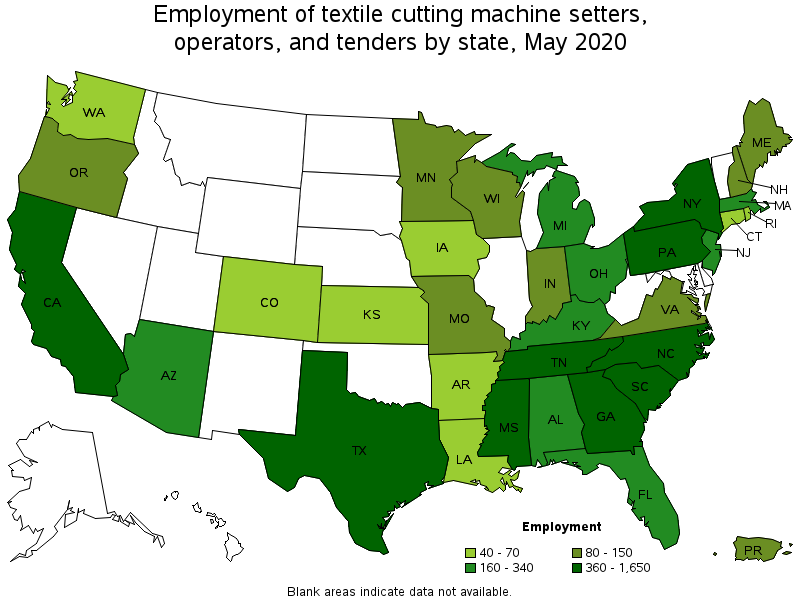
States with the highest employment level in Textile Cutting Machine Setters, Operators, and Tenders:
| State | Employment (1) | Employment per thousand jobs | Location quotient (9) | Hourly mean wage | Annual mean wage (2) |
|---|---|---|---|---|---|
| Georgia | 1,650 | 0.38 | 4.20 | $ 14.50 | $ 30,170 |
| North Carolina | 1,230 | 0.29 | 3.15 | $ 14.25 | $ 29,630 |
| California | 1,190 | 0.07 | 0.80 | $ 15.32 | $ 31,870 |
| Texas | 780 | 0.06 | 0.71 | $ 12.54 | $ 26,080 |
| Mississippi | 770 | 0.71 | 7.83 | $ 15.92 | $ 33,110 |
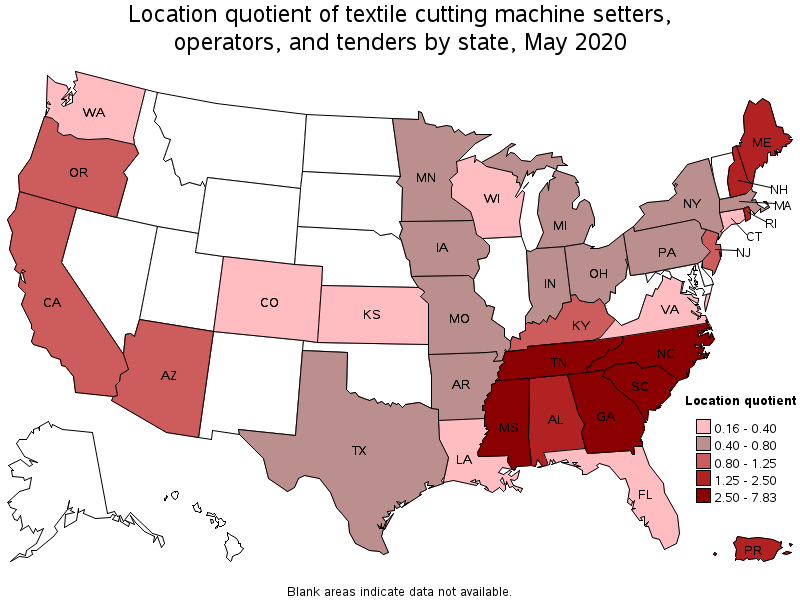
States with the highest concentration of jobs and location quotients in Textile Cutting Machine Setters, Operators, and Tenders:
| State | Employment (1) | Employment per thousand jobs | Location quotient (9) | Hourly mean wage | Annual mean wage (2) |
|---|---|---|---|---|---|
| Mississippi | 770 | 0.71 | 7.83 | $ 15.92 | $ 33,110 |
| Georgia | 1,650 | 0.38 | 4.20 | $ 14.50 | $ 30,170 |
| North Carolina | 1,230 | 0.29 | 3.15 | $ 14.25 | $ 29,630 |
| South Carolina | 510 | 0.25 | 2.79 | $ 14.12 | $ 29,380 |
| Tennessee | 730 | 0.25 | 2.76 | $ 14.15 | $ 29,430 |
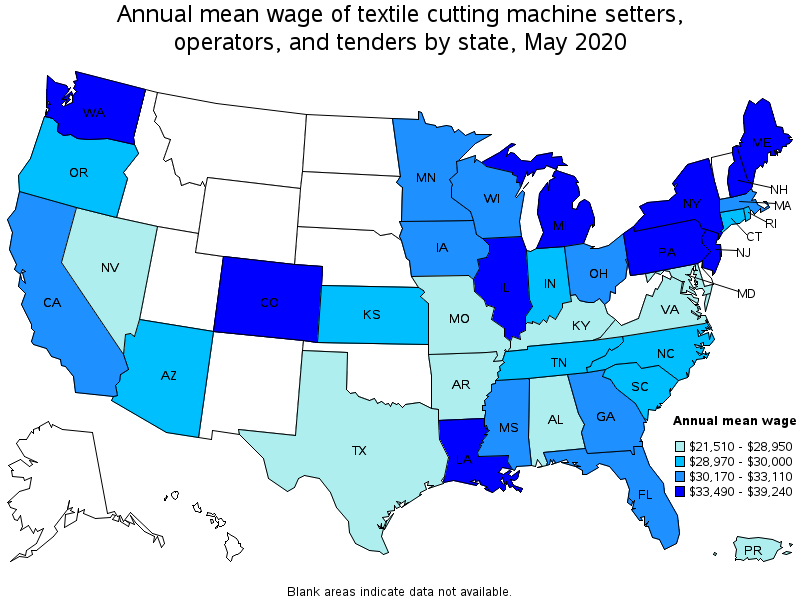
Top paying states for Textile Cutting Machine Setters, Operators, and Tenders:
| State | Employment (1) | Employment per thousand jobs | Location quotient (9) | Hourly mean wage | Annual mean wage (2) |
|---|---|---|---|---|---|
| Louisiana | 50 | 0.03 | 0.31 | $ 18.87 | $ 39,240 |
| Washington | 70 | 0.02 | 0.25 | $ 18.77 | $ 39,040 |
| New Hampshire | 130 | 0.21 | 2.33 | $ 17.01 | $ 35,380 |
| New Jersey | 340 | 0.09 | 0.99 | $ 16.68 | $ 34,700 |
| Colorado | 40 | 0.01 | 0.16 | $ 16.63 | $ 34,600 |
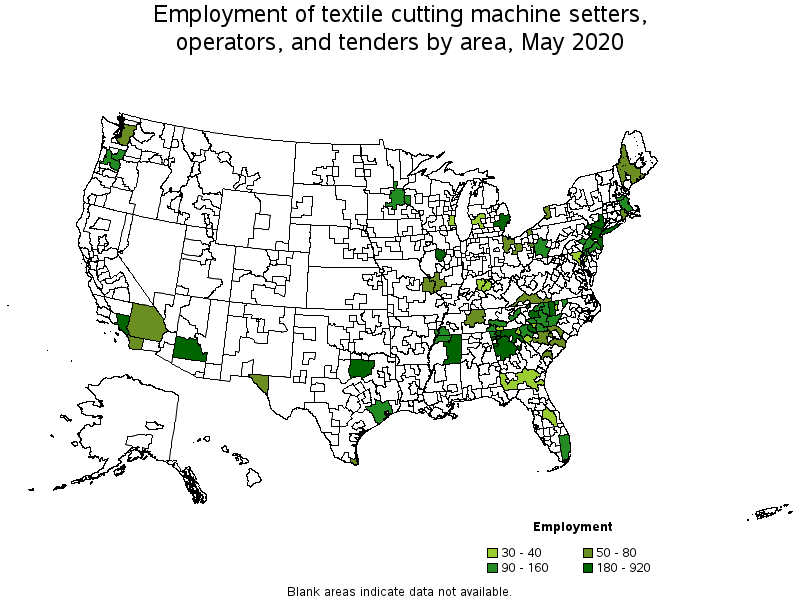
Metropolitan areas with the highest employment level in Textile Cutting Machine Setters, Operators, and Tenders:
| Metropolitan area | Employment (1) | Employment per thousand jobs | Location quotient (9) | Hourly mean wage | Annual mean wage (2) |
|---|---|---|---|---|---|
| Los Angeles-Long Beach-Anaheim, CA | 920 | 0.16 | 1.73 | $ 15.21 | $ 31,650 |
| New York-Newark-Jersey City, NY-NJ-PA | 590 | 0.07 | 0.74 | $ 16.51 | $ 34,350 |
| Dalton, GA | 530 | 8.80 | 96.76 | $ 15.11 | $ 31,430 |
| Atlanta-Sandy Springs-Roswell, GA | 510 | 0.19 | 2.12 | $ 14.79 | $ 30,770 |
| Dallas-Fort Worth-Arlington, TX | 360 | 0.10 | 1.10 | $ 12.38 | $ 25,740 |
| Hickory-Lenoir-Morganton, NC | 340 | 2.37 | 26.04 | $ 15.64 | $ 32,530 |
| Greensboro-High Point, NC | 300 | 0.85 | 9.38 | $ 14.48 | $ 30,120 |
| Peoria, IL | 270 | 1.69 | 18.62 | $ 22.43 | $ 46,660 |
| Phoenix-Mesa-Scottsdale, AZ | 250 | 0.12 | 1.28 | $ 13.94 | $ 28,990 |
| Detroit-Warren-Dearborn, MI | 180 | 0.10 | 1.10 | $ 16.51 | $ 34,340 |
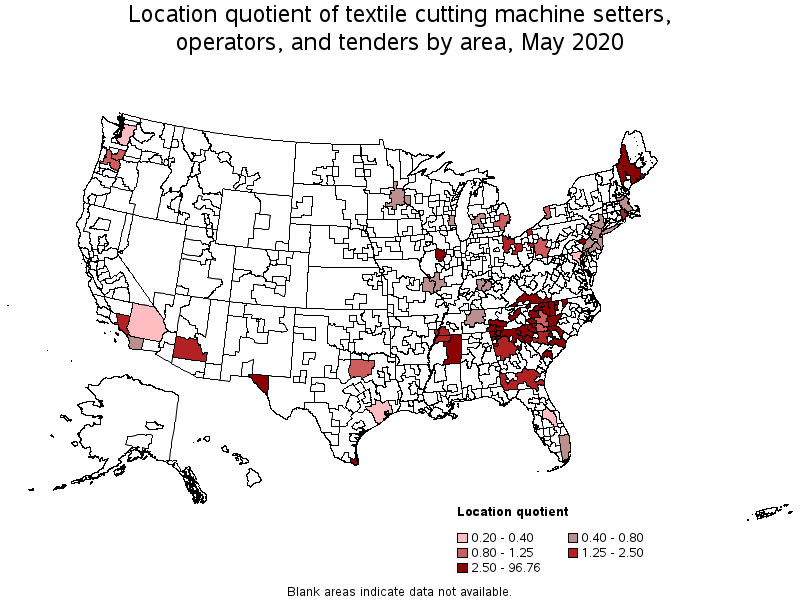
Metropolitan areas with the highest concentration of jobs and location quotients in Textile Cutting Machine Setters, Operators, and Tenders:
| Metropolitan area | Employment (1) | Employment per thousand jobs | Location quotient (9) | Hourly mean wage | Annual mean wage (2) |
|---|---|---|---|---|---|
| Dalton, GA | 530 | 8.80 | 96.76 | $ 15.11 | $ 31,430 |
| Hickory-Lenoir-Morganton, NC | 340 | 2.37 | 26.04 | $ 15.64 | $ 32,530 |
| Peoria, IL | 270 | 1.69 | 18.62 | $ 22.43 | $ 46,660 |
| Spartanburg, SC | 180 | 1.13 | 12.43 | $ 13.33 | $ 27,740 |
| Greensboro-High Point, NC | 300 | 0.85 | 9.38 | $ 14.48 | $ 30,120 |
| Burlington, NC | 40 | 0.73 | 8.00 | $ 16.24 | $ 33,780 |
| Cleveland, TN | 30 | 0.66 | 7.23 | $ 11.85 | $ 24,650 |
| Chattanooga, TN-GA | 150 | 0.61 | 6.69 | $ 14.31 | $ 29,770 |
| Reading, PA | 90 | 0.56 | 6.18 | $ 15.13 | $ 31,470 |
| Winston-Salem, NC | 140 | 0.56 | 6.16 | $ 15.04 | $ 31,270 |
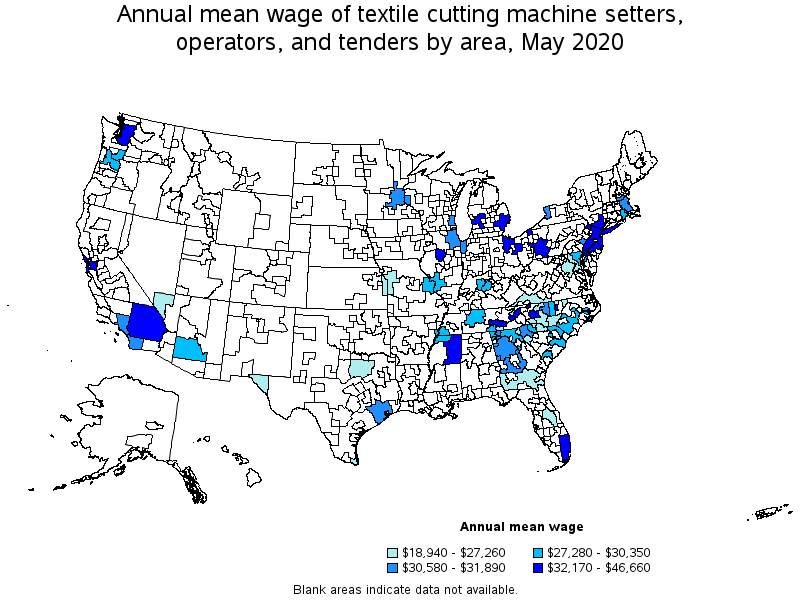
Top paying metropolitan areas for Textile Cutting Machine Setters, Operators, and Tenders:
| Metropolitan area | Employment (1) | Employment per thousand jobs | Location quotient (9) | Hourly mean wage | Annual mean wage (2) |
|---|---|---|---|---|---|
| Peoria, IL | 270 | 1.69 | 18.62 | $ 22.43 | $ 46,660 |
| Seattle-Tacoma-Bellevue, WA | 60 | 0.03 | 0.34 | $ 19.68 | $ 40,930 |
| Philadelphia-Camden-Wilmington, PA-NJ-DE-MD | 120 | 0.04 | 0.48 | $ 17.30 | $ 35,980 |
| San Francisco-Oakland-Hayward, CA | (8) | (8) | (8) | $ 16.63 | $ 34,600 |
| New York-Newark-Jersey City, NY-NJ-PA | 590 | 0.07 | 0.74 | $ 16.51 | $ 34,350 |
| Detroit-Warren-Dearborn, MI | 180 | 0.10 | 1.10 | $ 16.51 | $ 34,340 |
| Pittsburgh, PA | 90 | 0.08 | 0.92 | $ 16.25 | $ 33,800 |
| Burlington, NC | 40 | 0.73 | 8.00 | $ 16.24 | $ 33,780 |
| Miami-Fort Lauderdale-West Palm Beach, FL | 120 | 0.05 | 0.55 | $ 16.06 | $ 33,400 |
| Grand Rapids-Wyoming, MI | 40 | 0.07 | 0.76 | $ 15.92 | $ 33,120 |
Nonmetropolitan areas with the highest employment in Textile Cutting Machine Setters, Operators, and Tenders:
| Nonmetropolitan area | Employment (1) | Employment per thousand jobs | Location quotient (9) | Hourly mean wage | Annual mean wage (2) |
|---|---|---|---|---|---|
| Northeast Mississippi nonmetropolitan area | 720 | 3.21 | 35.25 | $ 16.06 | $ 33,410 |
| North Georgia nonmetropolitan area | 310 | 1.91 | 21.04 | $ 13.59 | $ 28,280 |
| Piedmont North Carolina nonmetropolitan area | 160 | 0.67 | 7.32 | $ 11.89 | $ 24,720 |
| East Tennessee nonmetropolitan area | 120 | 0.94 | 10.35 | $ 16.56 | $ 34,440 |
| Southwest Maine nonmetropolitan area | 60 | 0.35 | 3.80 | (8) | (8) |
Nonmetropolitan areas with the highest concentration of jobs and location quotients in Textile Cutting Machine Setters, Operators, and Tenders:
| Nonmetropolitan area | Employment (1) | Employment per thousand jobs | Location quotient (9) | Hourly mean wage | Annual mean wage (2) |
|---|---|---|---|---|---|
| Northeast Mississippi nonmetropolitan area | 720 | 3.21 | 35.25 | $ 16.06 | $ 33,410 |
| North Georgia nonmetropolitan area | 310 | 1.91 | 21.04 | $ 13.59 | $ 28,280 |
| East Tennessee nonmetropolitan area | 120 | 0.94 | 10.35 | $ 16.56 | $ 34,440 |
| Piedmont North Carolina nonmetropolitan area | 160 | 0.67 | 7.32 | $ 11.89 | $ 24,720 |
| Upper Savannah South Carolina nonmetropolitan area | 40 | 0.50 | 5.55 | $ 12.55 | $ 26,090 |
Top paying nonmetropolitan areas for Textile Cutting Machine Setters, Operators, and Tenders:
| Nonmetropolitan area | Employment (1) | Employment per thousand jobs | Location quotient (9) | Hourly mean wage | Annual mean wage (2) |
|---|---|---|---|---|---|
| North Northeastern Ohio nonmetropolitan area (noncontiguous) | 50 | 0.15 | 1.63 | $ 17.17 | $ 35,710 |
| East Tennessee nonmetropolitan area | 120 | 0.94 | 10.35 | $ 16.56 | $ 34,440 |
| Northeast Mississippi nonmetropolitan area | 720 | 3.21 | 35.25 | $ 16.06 | $ 33,410 |
| Middle Georgia nonmetropolitan area | (8) | (8) | (8) | $ 14.70 | $ 30,580 |
| Southeast Coastal North Carolina nonmetropolitan area | (8) | (8) | (8) | $ 14.05 | $ 29,220 |
These estimates are calculated with data collected from employers in all industry sectors, all metropolitan and nonmetropolitan areas, and all states and the District of Columbia. The top employment and wage figures are provided above. The complete list is available in the downloadable XLS files.
The percentile wage estimate is the value of a wage below which a certain percent of workers fall. The median wage is the 50th percentile wage estimate—50 percent of workers earn less than the median and 50 percent of workers earn more than the median. More about percentile wages.
(1) Estimates for detailed occupations do not sum to the totals because the totals include occupations not shown separately. Estimates do not include self-employed workers.
(2) Annual wages have been calculated by multiplying the hourly mean wage by a "year-round, full-time" hours figure of 2,080 hours; for those occupations where there is not an hourly wage published, the annual wage has been directly calculated from the reported survey data.
(3) The relative standard error (RSE) is a measure of the reliability of a survey statistic. The smaller the relative standard error, the more precise the estimate.
(8) Estimate not released.
(9) The location quotient is the ratio of the area concentration of occupational employment to the national average concentration. A location quotient greater than one indicates the occupation has a higher share of employment than average, and a location quotient less than one indicates the occupation is less prevalent in the area than average.
Other OEWS estimates and related information:
May 2020 National Occupational Employment and Wage Estimates
May 2020 State Occupational Employment and Wage Estimates
May 2020 Metropolitan and Nonmetropolitan Area Occupational Employment and Wage Estimates
May 2020 National Industry-Specific Occupational Employment and Wage Estimates
Last Modified Date: March 31, 2021